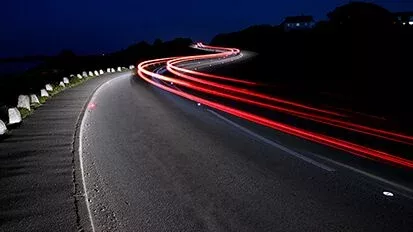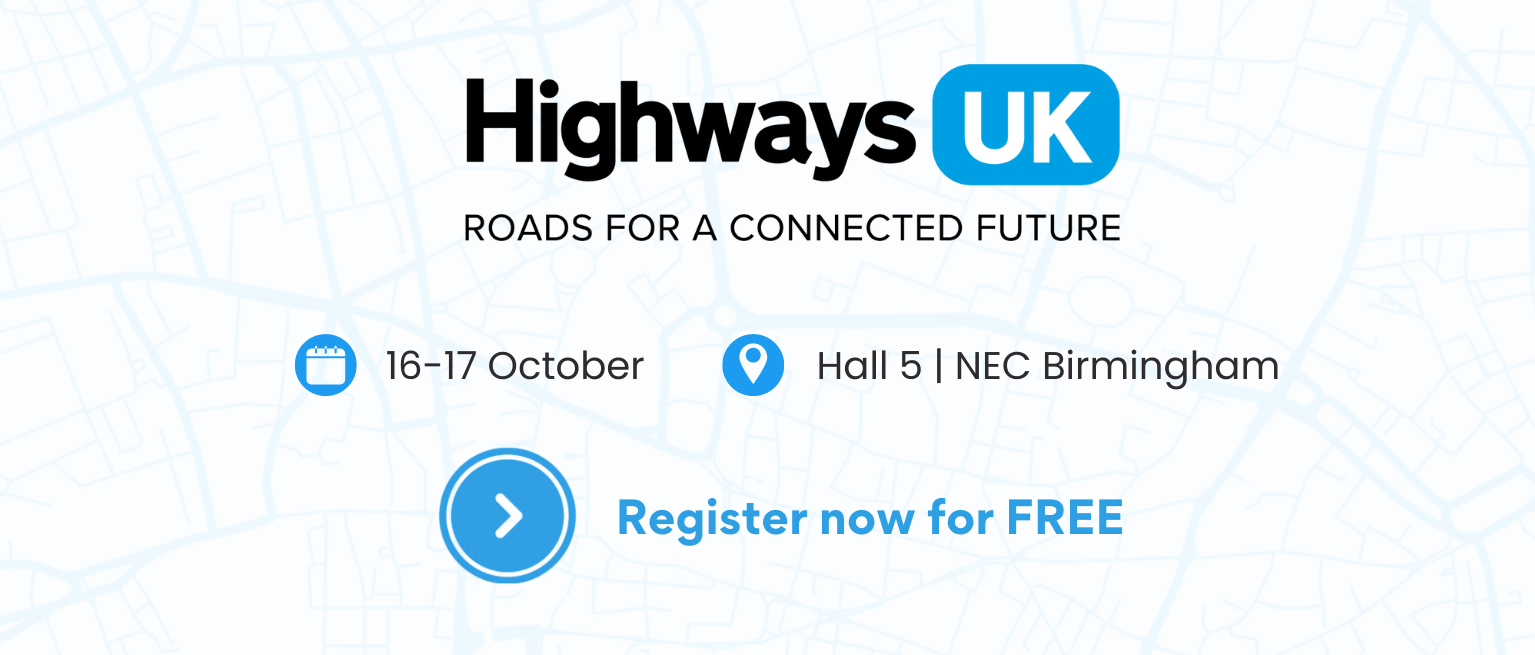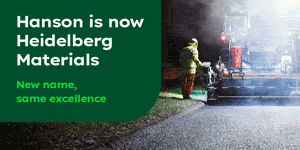Active road studs can have a significant positive effect on driver confidence where installed, according to the results of a new study by the Transport Research Institute at Edinburgh Napier University.
The study, Active Road Studs as an Alternative to Lighting on Rural Roads: Driver Safety Perception, the first of its kind to investigate the effects of the use of active road studs on the confidence of drivers at night, found that whilst demand for street lighting may remain, active road studs have a significant positive effect on driver confidence where installed. This increase in confidence appears to be mainly due to an improved preview time of the road ahead, combined with assisting mitigation of the detrimental effects of glare from oncoming vehicles.
The paper from the study said that ‘benefits’ can be expected across all user groups, with particular benefits for elderly and female drivers. It is suggested that positive improvements to journey opportunities may result, although further longitudinal study may be required to confirm this. Nevertheless, it is anticipated the work should provide confidence to roads engineers that the active road stud is likely to be of benefit to road users. On this basis, the stud may be considered a more sustainable intervention than street lighting, particularly in circumstances where driver- safety perception is an issue.
Research lead, Richard Llewellyn of the Transport Research Institute, Edinburgh Napier University, told Highways News: “Our research over many years has showed that intelligent road studs can have a positive effect on driver behaviour. The use of intelligent road studs offers a cost-effective and sustainable alternative to streetlighting or where lighting installation is not possible. Use of intelligent road studs was also proven to be useful on bends in the road network and at junctions to help drivers gain more appreciation for what was in front of them as they emerged, for example.”
Early work on the project focused on research around the Sheriffhall Roundabout on the A720 in Scotland. Here, actively controlled road studs were used whereby the studs are synchronised in coordination with the A720 traffic signals on the roundabout. With the new system in place, as soon as the traffic signal on the entrance to the roundabout turns green, studs embedded in the road surface immediately illuminate and guide drivers onto the appropriate lanes of the roundabout. As the traffic signal turns red, all of the studs on that section switch off and the studs at the next section illuminate as the corresponding traffic signal turns green. In this way, drivers now get an illuminated green phase to guide them all the way around and off the roundabout, with clear visual definition of the lanes to heighten lane discipline and reduce preventable collisions.
Mr Llewellyn’s paper on the Sheriffhall Roundabout; Lighting the Way: The use of intelligent road studs at spiral-marked roundabouts, points to research that says there was a 60% reduction in partial lane transgressions and a 45% reduction in full lane changes as a result of the studs being used.
The conclusions, according to the paper, suggest that the road stud has a positive impact on driver behaviour when implemented in the context of a spiralmarked roundabout. Lane discipline is likely to be improved and as a result, the probability of vehicle conflicts is reduced. There may also be benefits to traffic flow due to improved predictability of paths through the roundabout, it said.
The paper went on to say that given the potential benefits gained above, the intelligent road stud is recommended for consideration as a low-cost road safety measure at problematic spiral marked roundabout sites. Whilst it is not a panacea for all lane transgression issues, the evidence presented suggested that it can result in significant improvement and has the potential to reduce the costs of accidents and related traffic delay.
More recent work on the project included looking at intelligent studs installed on the A1 in Scotland. For a number of years, residents and regular travellers campaigned for improvements to be made to address perceived issues of safety along the route. Despite this, a review by Transport Scotland reported to local elected members that only two slight injury collisions had been recorded over the period covered. However, the review also found during hours of darkness, the visibility of junctions on the route could be perceived as poor and an improvement scheme was subsequently developed to address user concerns. The scheme comprised the use of LED Active Road Studs to highlight junctions and selected links with a view to improving the perception of safety and the experience of users. In total, over 4200 studs were installed at nine junctions, including two intermediate stretches of carriageway.
The research here was based around assessing the importance of road features during hours of darkness and the opinion of active road studs in this context. Respondents were asked to rate on a five-point Likert scale varying from ‘not important’ through to ‘very important’ the following six features: street lighting at junctions; street lighting on curves; road studs at junctions; road studs on curves; solid white lines at edges of road; and white line markings in the centre of the road. They were also asked on a five-point scale from ‘strongly worsened’ through to ‘strongly improved’ whether the introduction of the active road stud had altered their opinion on seven themes: clarity of junctions; clarity of curves; clarity of lanes; their confidence driving in darkness; their opportunities for travel; overall safety; and incidence of speeding on the route.
Drivers reported a very positive response to the active road stud as a road feature at night. Overall, 93% of respondents reported an improvement in the clarity of junctions, curves and lanes on the route. Positive changes in safety perception were also found. A total of 80% believed the overall safety of the A1 route had improved, with a third of respondents stating that their opportunities for travel had increased. In total, 72% of respondents reported an improved level of confidence driving in darkness.
Significantly, the response to the use of the active road stud was found to be highly positive across all demographic groups, with strong support for wider use on the road network. Most notable was that users believed the safety of the route had been improved with a resulting increase in confidence. In improving driver confidence, it is suggested that the active road stud may potentially contribute to addressing such concerns, particularly in situations where alternative travel options are limited, such as rural areas, said the results of the research.
Both the quantitative and qualitative data presented suggest the first reason for the increase in driver confidence related to the studs is the improvement in clarity of road features, such as junctions and curves, as well.
The responses to the survey also suggest that the active road stud not only assists in highlighting the road itself, but also in mitigating difficulties caused by the presence of other vehicles.
The diminishing of the importance of lighting with increasing confidence due to other road features, in particular the active road stud, is a key contribution to knowledge made by this study. “In practice, what this may suggest is that in situations where lighting brings with it a high cost (either financial or environmental) or potential disbenefit (decreased concentration or increased speeds), the active road stud might be considered as a viable alternative by road engineers. In this way, the active road stud could contribute to increasing driver confidence at night and thereby potentially opening journey opportunities, particularly where alternative modes are limited. Given the issue of confidence driving at night is known to disproportionately affect female and elderly road users, use of such a measure could also address concerns of equality in access to transport, particularly in rural areas,” said the study.
“It would appear from the results presented that the studs have a high level of benefit at a relatively low cost, particularly when compared with the installation of street lighting. Potentially, there may be even greater benefits arising from implementation of the studs, but these could only be quantified if the resultant actual changes in road safety are also accounted for,” it added.
Mr Llewellyn added: “Our work has shown the scheme as implemented has met the goals set of improving driver confidence by highlighting key features during hours of darkness, at a relatively low cost. This is important finding, particularly from a societal point-of-view. There is clear potential for even greater benefits to be gained if these changes in confidence result in positive changes to driver behaviour and a reduction in collision potential. The next phase of our research will look at changes to speed profiles and gap acceptance at junctions along the route, two significant causation factors in rural collisions. If positive changes can be found in these areas, the benefits of intelligent road studs in contribution to road safety targets could be even greater than those already shown.”
The six-year study by Edinburgh Napier University is due to complete and report final overall results this December.

























